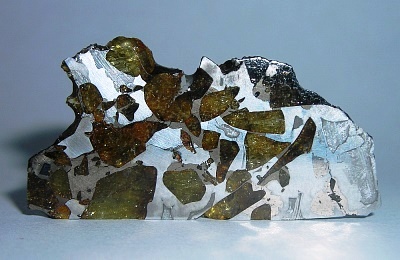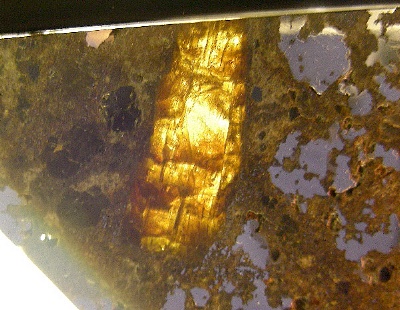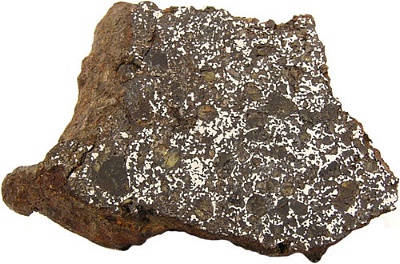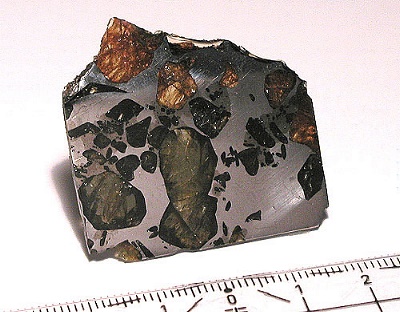IMCA Insights – November 2007
Our Favorite Stony-Iron Meteorites, Part 1
by the IMCA Board of Directors
This is the first part of Our Favorite Stony-Iron Meteorites, introducing you to some more fascinating samples that have a very special place in the hearts and in the collections of the IMCA Board Members. Enjoy!
Christian Anger:
The Marjalahti
pallasite belongs to the main group of pallasites and is one of the only
three pallasites whose fall was actually witnessed. The two other
pallasites seen to fall are Zinder and Omolon. Marjalahti fell June 1,
1902 at 10:00 p.m. in Viipuri, Karelia, USSR. The meteorite hit the
cliff over Lake Laatokka and split into many pieces in front of a
witness: J. Koppinen. Fragments were spread over a 50 meters wide area,
and some fell into the lake. The biggest pieces weigh 22.7 and 4.8 kg.
The total known weight is about 45 kg. There have been rumors that there
might be even bigger fragments in the lake, but Lake Laatokka is about
30 meters deep.
This is the only Finnish stony iron meteorite, since, at the time of the
fall, the area belonged to Finland, and the main mass of Marjalahti is
now in the Geological Museum of the University of Helsinki.
A fantastic 5.27g slice of Marjalahti, Coll. Christian Anger
My collection piece is an etched 5.27 g crusted partslice and it originally came from the renowned Rob Elliott collection. Have a look at the picture above.
A 1878g fragment of Marjalahti, Courtesy NHM Vienna
Here is a picture of the gorgeous, large 1,878g Marjalahti fragment in the Collection of the Museum in Vienna, showing black crust and wonderful olivine crystals.
Anne Black:
Estherville is hardly a rare meteorite. It fell in broad daylight, in the afternoon of May 10, 1879. It exploded in thousands of fragments and for weeks after that, families living in that area of Iowa took picnic baskets and went through the fields, gathering odd twisted pieces of this meteorite. It was eventually analyzed, and classified as a mesosiderite, a type of meteorite typically composed of roughly 50% irons and 50% silicates.
Close-up on a translucent slice of the Estherville mesosiderite
But what I like about this particular meteorite is its unpredictability. It is a mesosiderite, not a pallasite, but still, every now and then, you will look at a thin slice, and right there, you will see an olivine! just like if it was a pallasite. I know there is a perfectly good scientific explanation, but I prefer to call it the mesosiderite that wants to grow up to be a pallasite!
Jeff Kuyken:
The favourite Mesosiderite in my collection is NWA 1827 which was originally purchased in Rissani, Morocco as a single stone weighing 877g during June 2003. This meteorite was initially thought to resemble a "Metal Rich Diogenite" but once other comparative studies were done with NWA 1879, it was actually classified as a Mesosiderite; specifically the 2C subgroup. Several NWA Mesosiderites have now been found and classified under different numbers but they are mostly thought to belong to the same large heterogeneous Mesosiderite with a Total Known Weight exceeding 22kg. NWA Mesosiderites belonging to the 2C subgroup include: NWA 1827, NWA 1879, NWA 1882, NWA 1912, NWA 1951, NWA 1982, NWA 3055 and probably NWA 1645.
A fantastic 13.78g endcut of NWA 1827, Courtesy Jeff Kuyken
The mineralogy of this Mesosiderite is of a mostly medium-grained Igneous texture with some large mineral clasts of Orthopyroxene and Plagioclase which are commonly surrounded by metal-rich areas. This can be seen in the photographed 13.78g Endcut where the beautiful green/yellow Orthopyroxene crystals are surrounded by brilliant metallic Iron/Nickel. Some pieces of this meteorite also have Eucrite and Diogenite clasts.
Pierre-Marie Pelé:
Stony-irons meteorites
were the meteorites that got me interested in meteorites. Probably
because they are the prettiest of all meteorites. I discovered Esquel
when I first met Robert Haag in a mineral show in Paris. I was quite
impressed by the man (he is like a rock star) and by the Esquel slices
he showed me.
The Esquel meteorite was found by a farmer in 1951 in Argentina. The
total weight is uncertain, probably between 755 to 1,500 kilograms.
Robert Haag acquired the largest mass in 1992, and made it available to
collectors worldwide.
A 7.3g slice of the Esquel pallasite, Coll. Pierre-Marie Pelé
Since I started to collect meteorites, I had been dreaming of owning a piece of Esquel and finally one day, I bought this nice slice for my collection. It is small, only 7.3 grams but I love it. Esquel is also a very stable meteorite so it is for me one of the best buys.
More on our Favorite Stony-Iron Meteorites in a future edition of IMCA Insights. Stay tuned, and thanks for your interest!
•
IMCA Home Page •
IMCA Code of Ethics •
IMCA Member List
•
Join IMCA •
IMCA Meteorite Info



